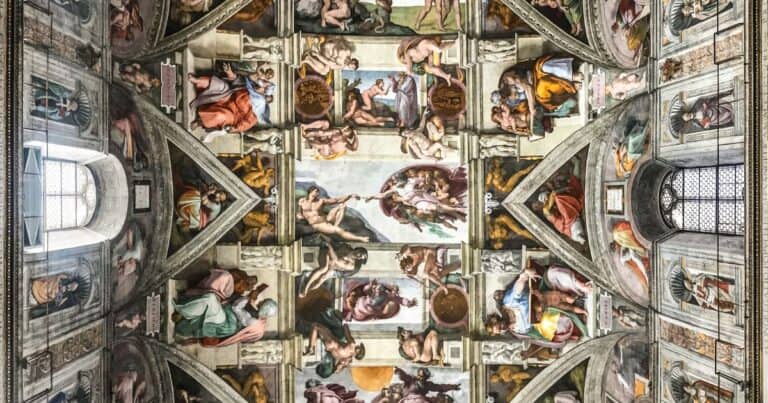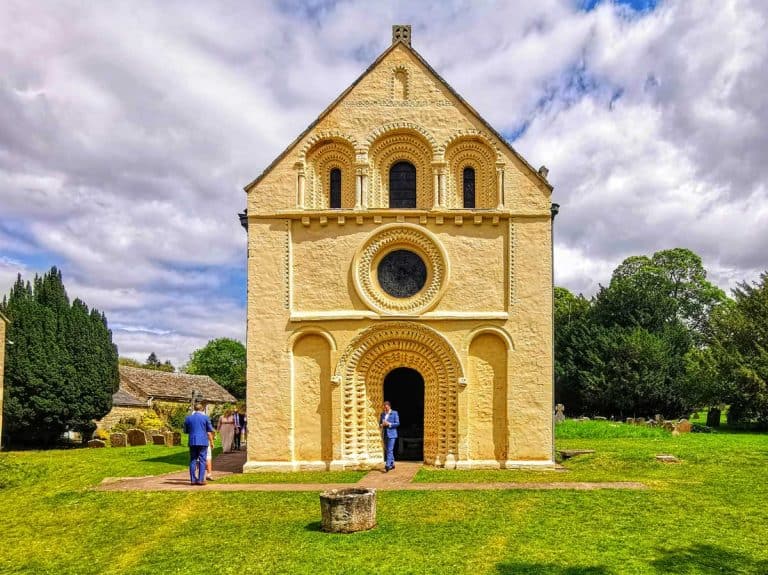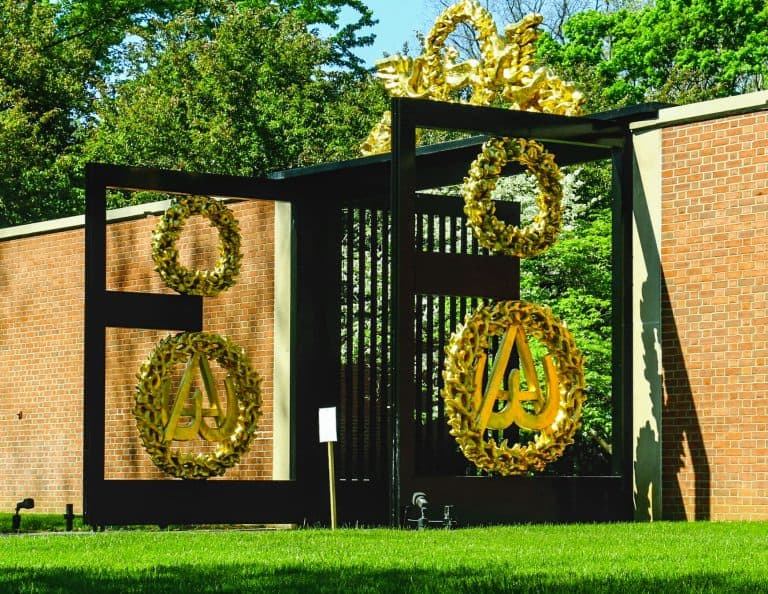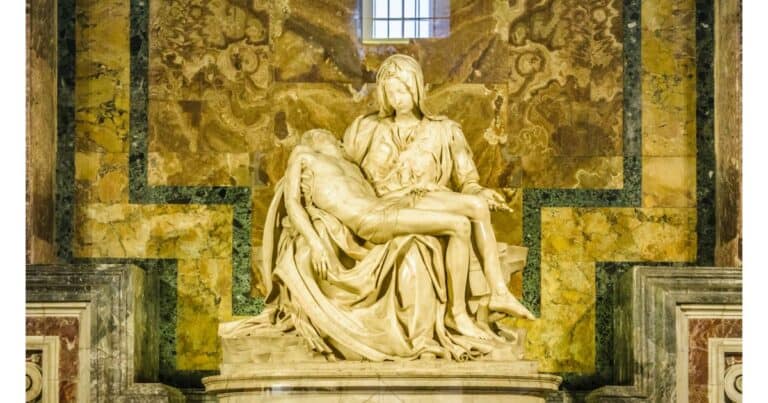Early Christian Mosaics: Stories Pieced Together in Stone and Hue
By Teresa Trumbly Lamsam, Ph.D.
In the dimly lit corridors of ancient basilicas, where the soft echo of whispered prayers meets the cool stone floors, lies the mesmerizing art of early Christian mosaics. These intricate masterpieces, crafted with painstaking precision, tell tales of faith, hope, and divine beauty.
When I gaze upon them, I feel transported back to an era where art and devotion intertwine seamlessly. The shimmering tiles, each holding a story, beckon you closer, inviting you to delve deeper into the rich tapestry of early Christian history.
I always imagine the craftsmanship that went into making the mosaics and how much it must cost to maintain them.
Join me for a vivid exploration of these mosaics, revealing not just their aesthetic allure but the profound spiritual significance they held for the communities that built and cherished them.
Historical Context of Early Christian Mosaics
In the vast reaches of the Roman Empire, as pagan beliefs waned and Christianity took root, early Christian mosaics stood as quiet testaments to this pivotal time. These mosaics, with their intricate designs and profound symbolism, became the canvas upon which the tales of newfound faith were painted.
In 380 CE, Emperor Theodosius I issued the Edict of Thessalonica, also known as “Cunctos populos,” which declared Nicene Christianity the official state religion of the Roman Empire. This significant decree not only solidified the status of Christianity within the Roman realm but also set the stage for its profound influence on subsequent global history.
The Roman Empire and the Rise of Christianity
As the cobblestone streets of ancient Rome bustled with activity, a quiet revolution took place. In hidden catacombs and modest homes, the message of Christ was spreading, and with it, the art of Christian mosaics began to flourish.
These mosaics, often set against the backdrop of grand Roman architecture, served as a testament to the resilience and fervor of early believers.
Transition from Pagan to Christian Art
The transition was subtle yet profound. Where once the mosaics celebrated the might of emperors and the whims of gods, they now began to echo the teachings of the Gospel. Scenes from pagan mythology gradually gave way to depictions of Christ, the Virgin Mary, and biblical narratives, marking a pivotal shift in artistic expression and spiritual focus.
Characteristics of Early Christian Mosaics
Each mosaic, a mosaic of countless tiny tesserae, was more than just a visual spectacle. It was a carefully crafted narrative, a blend of art and theology, designed to inspire and educate. The colors, symbols, and scenes chosen were not mere artistic choices; they were deliberate decisions, each carrying a depth of meaning.
Iconography and Symbolism
Delve deeper, and you’ll find a world rich in symbolism:
- Fish: An ancient symbol of Christ.
- Lamb: Representing sacrifice and purity.
- Good Shepherd: A comforting image of guidance and protection.
- Chi-Rho: An early Christogram formed by superimposing the first two letters of the Greek word for Christ.
- Dove: Symbolizing the Holy Spirit or peace.
- Anchor: Representing hope and steadfastness in faith.
- Alpha and Omega: Indicating that Christ is the beginning and the end.
- Peacock: Symbolizing immortality and resurrection.
These symbols, woven into the fabric of the mosaics, provided a visual language through which the early Christians could express their faith and devotion.
“By making use of both familiar and non-familiar Greco-Roman symbols, images, and icons, early Christian communities were able to situate their new religion among the already existing Greco-Roman culture, which allowed Christianity to establish a cultural cohesiveness and identity,” according to Tim Ganshirt’s thesis “The Greco-Roman Influence on Early Christian Art.”
You may also enjoy reading: The Tapestry of Faith: Exploring the Rich History of Medieval Christian Art
Color Palette and Materials
The hues of these mosaics were not chosen at random. The ethereal golds, deep blues, and rich reds each held significance, reflecting themes of divinity, royalty, and passion. And the materials? Sourced from near and far, they were a testament to the dedication of the artisans, who sought the finest stones and glasses to bring their visions to life.
The materials bore witness to both the artistry and resourcefulness of the craftsmen. Tiny tesserae, hand-cut pieces of stone, glass, or ceramic, were meticulously arranged, capturing ambient light and giving the mosaics a radiant glow.
Often, these artisans repurposed scrap pieces from other stonework projects, ensuring nothing went to waste. This practice not only added unique textures and character to the mosaics but also showcased the dedication and ingenuity of those who created them.
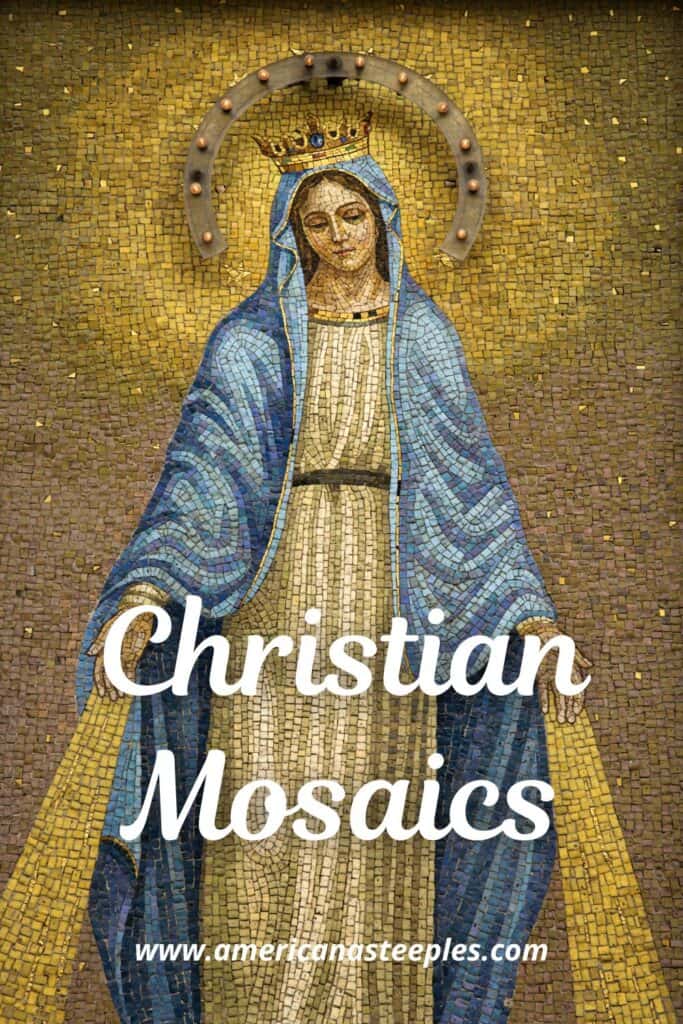
Notable Examples of Early Christian Mosaics
As we traverse the landscapes of ancient Europe and the Middle East, certain landmarks stand tall, their walls adorned with mosaics that have withstood the test of time. These are not just places of worship, but repositories of history, each mosaic telling a tale of faith, artistry, and devotion.
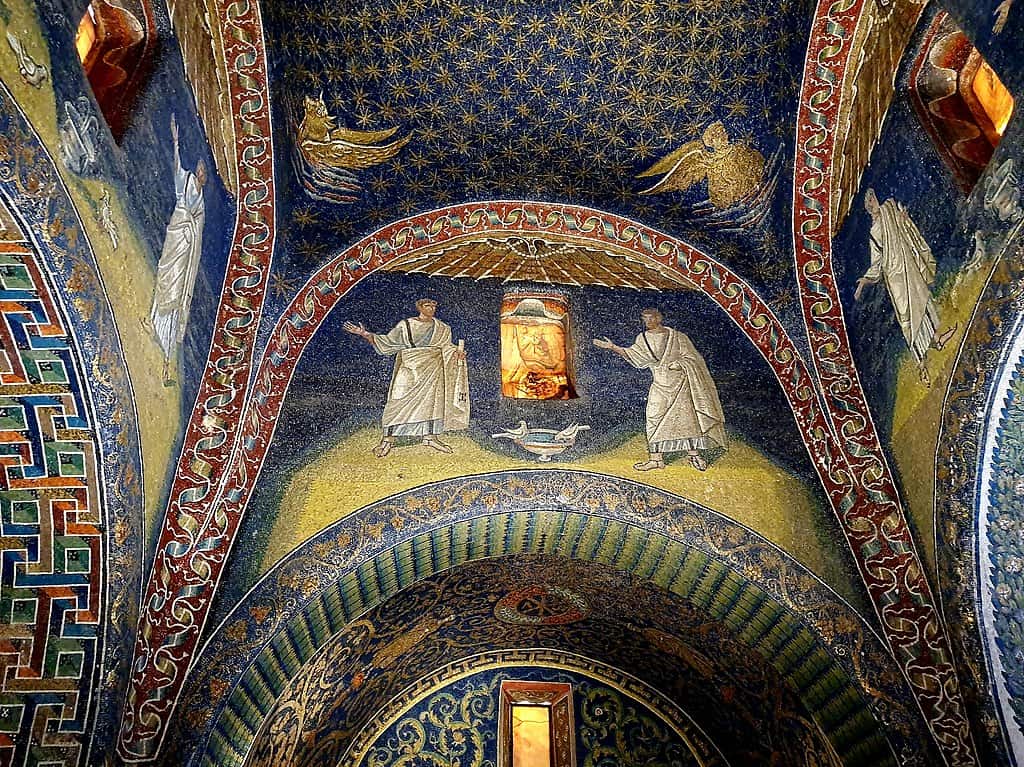
(Photo by Prof. Mortel, CC BY 2.0, via Wikimedia Commons)
The Mausoleum of Galla Placidia in Ravenna
Nestled in the heart of Ravenna, the Mausoleum of Galla Placidia stands as a beacon of early Christian art. As you step inside, the dim light casts a gentle glow on mosaics that shimmer with celestial blues and golds.
Each mosaic panel tells a story: from the sacrifice of Isaac to the vibrant depiction of Christ as the Good Shepherd amidst a verdant landscape. The intricate designs, combined with the play of light, create an atmosphere of serene reverence, making it a place where history, art, and spirituality intertwine.
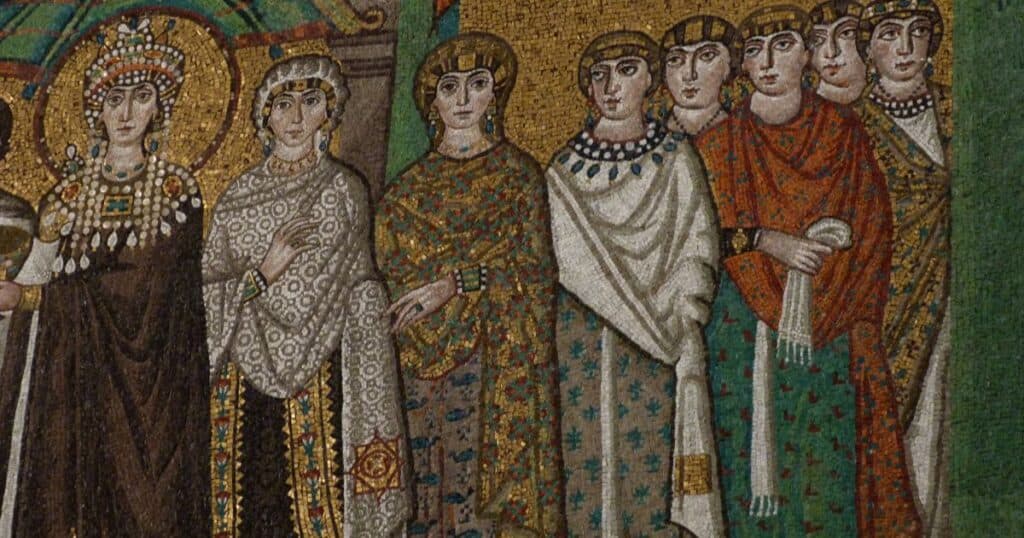
The Basilica of San Vitale
A short distance away, the Basilica of San Vitale stands as a grand testament to Byzantine influence on early Christian mosaics. The apse, adorned with the famed depiction of Christ in Majesty, is a masterclass in composition and color. Surrounding it are figures from Christian history, their stories unfolding in a dance of light and tesserae.
Drawing from The Byzantine Legacy, the mosaics in San Vitale blend religious and imperial themes. The apse showcases a beardless Christ on a blue globe, surrounded by angels and saints, including St. Vitalis and Bishop Ecclesius. Adjacent panels depict Emperor Justinian and Empress Theodora, emphasizing the church’s ties with the Byzantine Empire.
The vault of the presbytery features the Lamb of God amidst a vibrant scene from Revelation. The triumphal arch displays the apostles’ medallions with Christ central, underscoring the apostles’ significance.
Read more about Christian architecture: From Ancient Roots to Modern Marvels
Role of Mosaics in Early Christian Worship
In the hushed ambiance of early Christian churches, where the scent of incense wafted through the air and the soft hum of prayers resonated, mosaics played a pivotal role. They were more than mere decoration; they were visual sermons, guiding the faithful and deepening their connection to God.
Mosaics as a Medium for Storytelling
Imagine a time when many couldn’t read and stories were passed down orally. In this context, mosaics became the storytellers, their vivid scenes from the Old and New Testaments offering lessons, morals, and tales of divine intervention. They served as a bridge, connecting the congregation with the sacred narratives of their faith.
Mosaics as a Reflection of Divine Beauty
Gazing upon these mosaics, one can’t help but feel a sense of awe. The intricate patterns, the play of light on gold tesserae, and the ethereal figures all aimed to evoke a slice of heaven on earth. For early Christians, these mosaics were a reminder of the beauty of God’s creation and the promise of Heaven.
Early Christian Mosaics by Country
As Christianity spread across continents, they carried the art of mosaics, each region infusing its unique flavor and cultural essence into this divine craft.
Italy
Italy, with its rich tapestry of history and art, became a crucible for early Christian mosaics. The mosaics here, especially in cities like Rome and Ravenna, are a harmonious blend of Roman grandeur and Christian fervor. Each piece, whether in a grand basilica or a secluded chapel, tells tales of faith set against the backdrop of the Italian landscape.
We’ve already mentioned the incredible mosaic examples in Ravenna, but Italy has more to offer. You can find more in this article by Italy Magazine.
Greece
In Greece, the cradle of classical art, early Christian mosaics absorbed the elegance of Hellenistic traditions. The mosaics in places like Thessaloniki, are a testament to the seamless fusion of ancient Greek aesthetics with Christian narratives.
A prime example is the Rotunda of Galerius in Thessaloniki. Originally a Roman mausoleum, it was later converted into a Christian church. Its mosaics, dating back to the 4th century, showcase scenes from the life of Christ, set against backgrounds adorned with traditional Greek motifs and patterns, illustrating the harmonious blend of the two cultures.
Turkey (Ancient Anatolia)
Straddling between the East and West, Anatolia’s mosaics, especially in the Hagia Sophia, are a visual symphony of diverse influences. They echo tales of emperors, saints, and commoners, all under the watchful gaze of the divine.
The Hagia Sophia, an architectural marvel in Istanbul, houses some of the most exquisite early Christian mosaics. One particularly striking example is the Deesis Mosaic, located in the south gallery.

The faces in the mosaic are rendered with exceptional detail, capturing a depth of emotion that speaks to the viewer across the centuries. The eyes of Christ, intense and compassionate, are a focal point, drawing in those who gaze upon them. The use of gold tesserae in the background illuminates the figures, creating an ethereal glow that underscores the divine nature of the scene.
Israel and Palestine
Walking through the Holy Land, you can’t help but feel the weight of history. The mosaics here, in places like Bethlehem’s Church of the Nativity, are poignant reminders of Christianity’s roots, each stone resonating with stories of miracles and faith.
The Church of the Nativity in Bethlehem, believed to be the birthplace of Jesus, is adorned with mosaics that date back to various periods of its long history. One of the most notable is the Angel Mosaic, a fragment of a larger composition from the Crusader era. This mosaic depicts an angel pointing toward the cave where Jesus is believed to have been born.
North Africa’s Mosaic Legacy
In the sun-drenched landscapes of North Africa, mosaics stand as vibrant testimonies to a region steeped in cultural confluence. Spanning centuries, from the Roman era to the Islamic period, these mosaics are a kaleidoscope of influences, echoing African, Roman, and Byzantine legacies.
The Romans, with their penchant for grandeur, introduced the art of mosaics to North Africa. Their mosaics often celebrated mythological tales, such as the labors of Hercules or the adventures of Dionysus. These pieces, characterized by their vivid colors and stylized forms, adorned the floors of villas and public buildings.
However, with the advent of Christianity in the 4th century AD, the narrative shifted. Mosaics began to mirror Christian themes, capturing scenes from the life of Christ or venerating figures like the Virgin Mary. Unlike their Roman predecessors, these mosaics leaned towards realism, capturing the essence of their subjects with a newfound depth.
The Islamic conquest in the 7th century AD introduced another layer of artistic expression. Mosaics began to reflect Islamic motifs, emphasizing geometric patterns and abstract designs over figurative representations. Yet, the essence of North African artistry, with its vibrant colors and intricate patterns, remained intact.
A mosaic-rich heritage awaits exploration in North Africa:

Volubilis, Morocco
A UNESCO World Heritage site, Volubilis boasts mosaics that capture both Roman myths and scenes of daily life. The “Labors of Hercules” mosaic is particularly noteworthy, offering a detailed narrative of the hero’s legendary tasks.
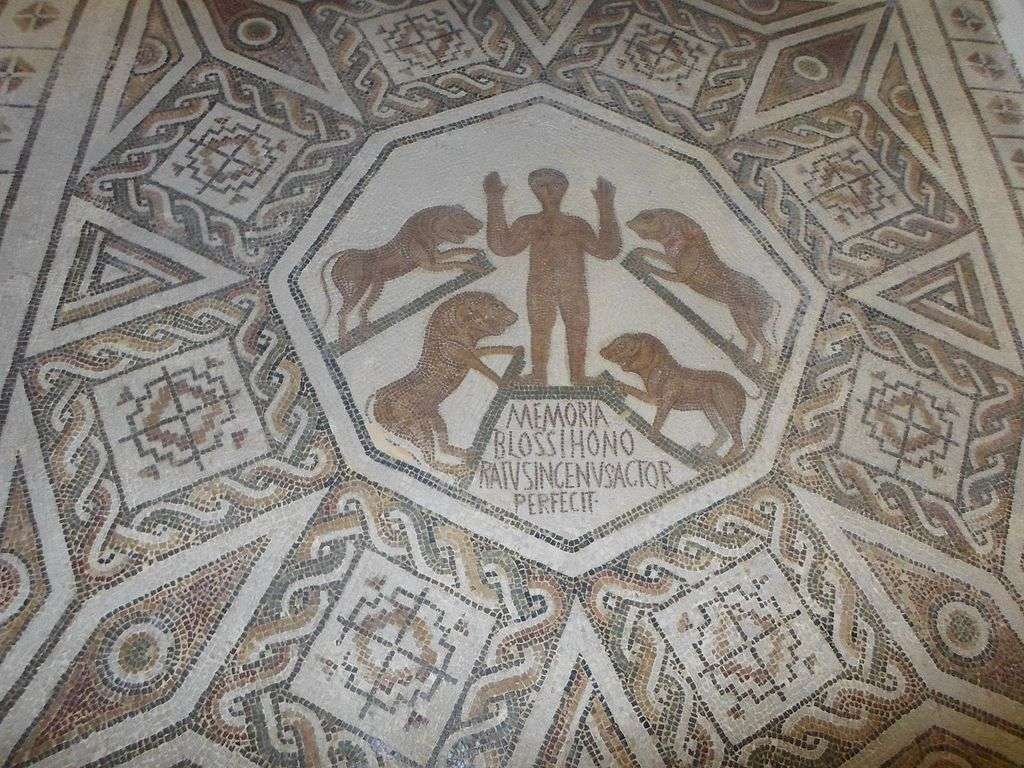
Mosaic of Daniel in the Lion’s Den in the Bardo National Museum, CC BY-SA 4.0, via Wikimedia Commons
Bardo Museum, Tunis, Tunisia
This treasure trove houses a vast collection of mosaics from both the Roman and Christian periods. Each piece offers a window into the region’s past, celebrating its diverse influences and shared heritage.
Spain
The Iberian Peninsula, a bridge between Europe and Africa, has always been a melting pot of cultures. This rich tapestry of influences is vividly reflected in Spain’s early Christian mosaics, a blend of various artistic traditions.
The Visigoths, a Germanic tribe, left an indelible mark on the Iberian Peninsula from the 5th to the 8th centuries. Their mosaics, while rooted in Christian themes like the life of Christ or the Virgin Mary, also bore the distinct stamp of Visigothic artistry, known for geometric patterns.
However, the landscape of artistry shifted with the Moorish conquest in the 8th century. Although the production of Christian mosaics slowed, those crafted bore subtle traces of Moorish influence. The mosaics in the Mausoleum of Centcelles in Tarragona, for instance, showcase a deer hunt, a theme prevalent in Moorish art.
The Reconquista, starting in the 11th century, heralded a renaissance in Christian mosaic art. This era saw mosaics that were not only more vibrant but also encompassed a broader spectrum of themes, from religious narratives to secular scenes and portraits.
A few mosaic masterpieces from this region include:
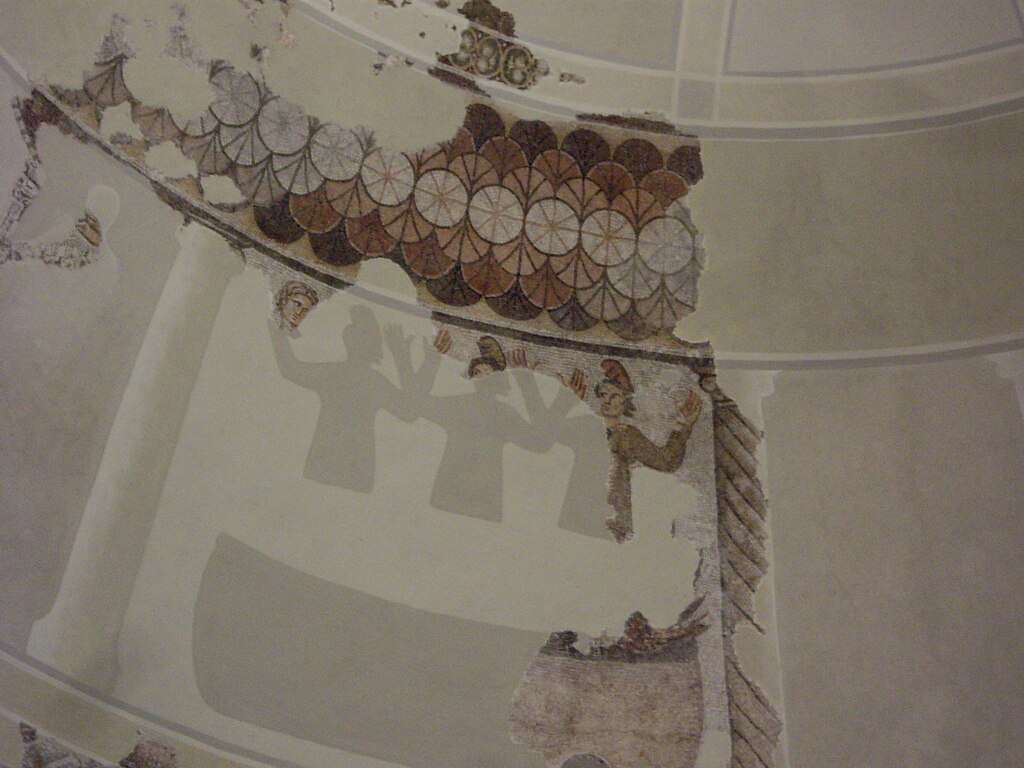
Mausoleum of Centcelles, Tarragona
Built in the 4th century, possibly by a Visigoth noble, this mausoleum is adorned with mosaics that depict a diverse range of scenes, from a deer hunt and a chariot race to biblical narratives.
Basilica of Santa María de Melque, Toledo
A 7th-century creation of the Visigoths, the mosaics here are deeply rooted in Christian symbolism, portraying the life of Jesus Christ and the Virgin Mary.
Cathedral of Tarragona
Constructed in the 12th century, the cathedral’s mosaics are a visual feast, showcasing a mix of religious themes, secular scenes, and detailed portraits.
Through these mosaics, Spain’s rich history of cultural exchange and artistic evolution comes alive, painting a vivid picture of its past.
Final Thoughts
As our journey through the world of early Christian mosaics draws to a close, we’re left with a profound sense of reverence. These mosaics, with their kaleidoscope of colors and tales, are not just art; they’re windows into the soul of an era. They remind us of the enduring power of faith, the beauty of artistic expression, and the timeless dance between history and spirituality.
FAQs
In our exploration, questions naturally arise, each seeking to delve deeper into the mysteries of these mosaics.
What sets early Christian mosaics apart from their Byzantine successors?
Early Christian mosaics, rooted in the nascent stages of the faith, often showcased simpler designs and a focus on biblical narratives. As we transition to the Byzantine era, there’s a noticeable shift toward more intricate patterns, lavish use of gold, and a stronger emphasis on depicting Christ, saints, and emperors in a more regal, otherworldly manner.
How did the socio-political climate influence the art of mosaics?
The socio-political environment played a pivotal role. As Christianity gained favor, especially post the Edict of Milan, mosaics transitioned from clandestine catacombs to grand basilicas. The art reflected the church’s growing power, with mosaics often commissioned by emperors or high-ranking clergy, showcasing both religious fervor and political might.
Why do we see a blend of pagan and Christian themes in some mosaics?
The early Christian era was a time of transition. Paganism and Christianity coexisted, often overlapping. Mosaics from this period sometimes incorporated pagan symbols, not as a nod to polytheistic deities but as metaphors reinterpreted within a Christian context. For example, the Orpheus mosaic, while rooted in Greek mythology, was seen by some early Christians as a symbol of Christ the shepherd.
How have modern restoration efforts impacted these ancient masterpieces?
Modern restoration, while well-intentioned, walks a fine line between preservation and alteration. While many mosaics have been brought back to their former glory, revealing hidden details and vibrant colors, there’s also a risk of losing the original essence. It’s a delicate dance between reviving the past and maintaining authenticity.
What lessons can contemporary artists draw from early Christian mosaics?
Beyond technique and craftsmanship, early Christian mosaics teach the power of storytelling through art. They remind us of the importance of symbolism, the interplay of light and color, and the profound impact of embedding deeper meanings within visual representations. For the modern artist, they serve as a testament to the timeless nature of art that resonates with emotion and purpose.

Teresa Trumbly Lamsam, Ph.D., is an accomplished Social Scientist and Journalist. Passionate about establishing credibility in the digital realm, she champions transparent and trustworthy online content. She is dedicated to producing content that sparks curiosity and nourishes the heart and mind.


